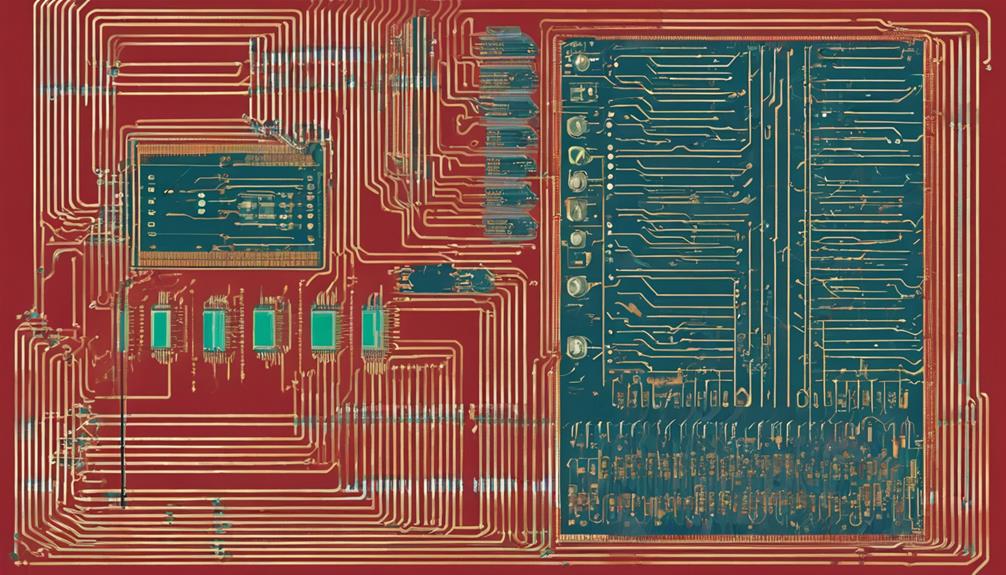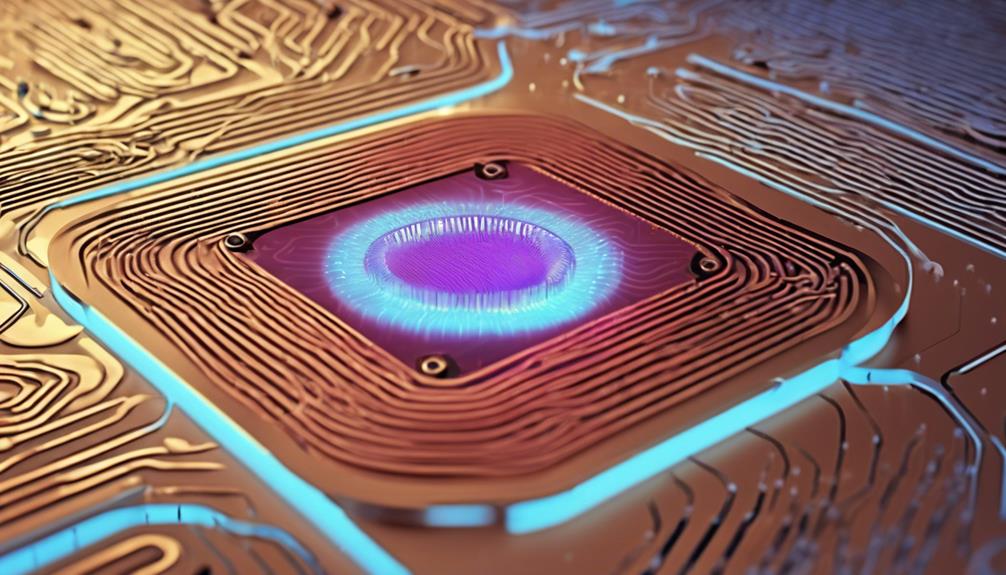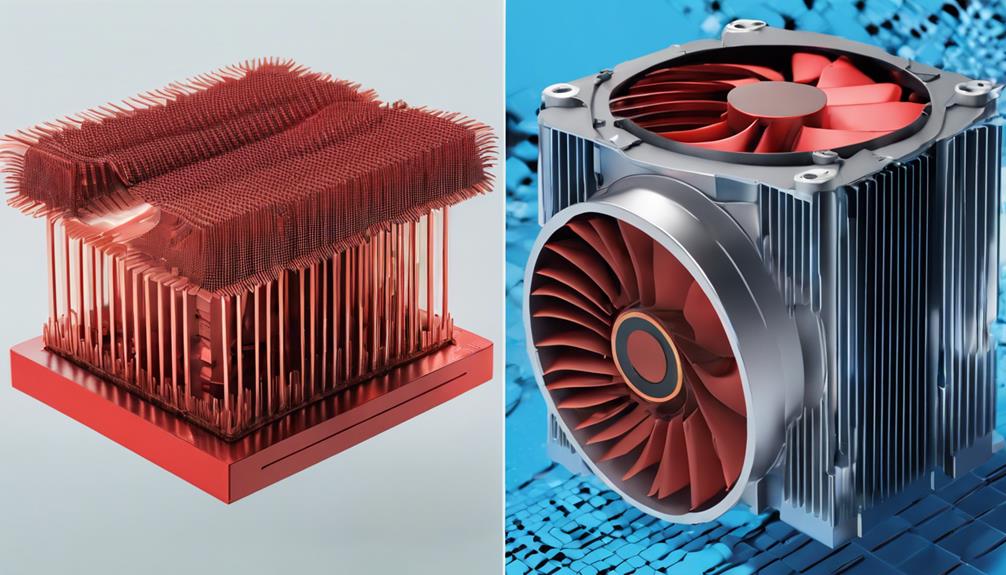Effective thermal analysis relies on a set of design rule checks that mitigate the risk of thermal-related failures and guarantee reliable operation of electronic systems. Seven essential checks include thermal expansion coefficient checks, via placement and distribution, conductor width and spacing rules, material compatibility assessment, thermal cycling simulation tests, heat sink geometry optimization, and design for airflow. These checks prevent thermal stresses and failures, facilitate heat dissipation, and assure component reliability. By incorporating these design rule checks, designers can optimize PCB layouts for thermal stability and create robust electronic systems that operate efficiently under various thermal conditions, and exploring these critical checks further reveals the intricacies of thermal management in electronic designs.
Key Takeaways
- Conduct thermal expansion coefficient checks to ensure material compatibility and prevent thermal stresses and failures.
- Implement via placement and distribution rules to facilitate heat dissipation and prevent thermal hotspots.
- Establish conductor width and spacing rules to impact heat dissipation, reliability, and current carrying capacity.
- Perform material compatibility assessments to evaluate thermal conductivity, Tg, and coefficient of thermal expansion.
- Utilize thermal cycling simulation tests to evaluate reliability under temperature fluctuations and identify potential failures.
Thermal Expansion Coefficient Checks
During the design process, thermal expansion coefficient checks are essential to guarantee that materials with differing coefficients of thermal expansion (CTE) are compatible, thereby preventing reliability issues and potential failures.
The importance of these checks lies in the fact that materials like copper and FR4 have distinct CTE values, which can lead to thermal stresses and failures if not addressed. By understanding the variations in CTE, designers can predict and mitigate thermal stresses, ensuring the dependability of their designs.
Implementing thermal expansion coefficient checks enables the optimization of PCB layout for thermal stability and performance. This is achieved through design rule checks that verify the compatibility of materials, thereby preventing reliability issues arising from thermal expansion differentials.
Via Placement and Distribution

Proper via placement and distribution are vital components of thermal management in PCB designs, as they facilitate efficient heat dissipation and prevent thermal hotspots. Strategic via placement helps in transferring heat away from critical components, ensuring reliable operation and preventing overheating.
Uniform via distribution is essential to prevent thermal hotspots, which can lead to component failure. Well-placed vias can greatly improve thermal performance and reliability of the PCB.
When determining via placement, it is important to take into account the thermal conductivity of the PCB material. This ensures effective thermal management and heat dissipation. Thermal analysis is essential in identifying areas of high thermal activity, allowing for optimized via placement and distribution.
Conductor Width and Spacing Rules

In PCB design, conductor width and spacing play a critical role in thermal management, as they directly impact heat dissipation, current carrying capacity, and overall reliability. Maintaining proper conductor width and spacing is essential for efficient heat dissipation on the PCB.
Conductor width influences current carrying capacity and thermal performance, with narrower widths resulting in higher resistance and heat buildup. Adequate spacing between conductors prevents short circuits and thermal issues, ensuring effective thermal management and reliability.
Following design rules for conductor width and spacing ensures efficient thermal management and reliability. Narrow conductor widths may result in higher resistance and heat buildup, compromising the overall performance of the PCB.
By adhering to strict spacing rules, designers can prevent thermal hotspots and ensure effective heat dissipation. By optimizing conductor width and spacing, designers can achieve effective heat dissipation, reducing the risk of thermal-related failures.
Material Compatibility Assessment

Material compatibility assessment is a critical aspect of thermal analysis. It guarantees that the selected PCB materials can withstand the thermal conditions expected during operation, thereby preventing potential failures and ensuring reliable performance.
This assessment involves evaluating the coefficient of thermal expansion (CTE) of materials to prevent issues like delamination or warping due to thermal stress. Understanding the thermal conductivity of materials is also essential, as it helps optimize heat dissipation and prevent hot spots on the PCB.
Moreover, compatibility assessment considers the Tg (glass transformation temperature) of materials to make sure they remain stable under high temperatures during assembly processes. Proper material selection based on thermal properties is vital for the reliability and performance of the PCB in thermal analysis.
Thermal Cycling Simulation Tests

Thermal cycling simulation tests play a critical role in evaluating the reliability of PCB components by subjecting them to repetitive temperature fluctuations that mimic real-world operating conditions. This type of testing is essential to assess the effects of temperature fluctuations on PCB components, helping to identify potential failures caused by the expansion and contraction of materials.
By subjecting the PCB to varying temperatures, designers can guarantee reliability under real-world conditions, thereby predicting the lifespan and durability of electronic devices. Thermal cycling simulations reveal weak points in the design that may lead to mechanical stress or fatigue, allowing designers to address these issues early on.
Understanding thermal cycling behavior is crucial for predicting the lifespan and durability of electronic devices. By incorporating thermal cycling simulation tests into the design process, designers can create more robust and reliable PCB designs that can withstand the rigors of real-world operating conditions, ultimately ensuring the durability and reliability of electronic devices.
Via Aspect Ratio and Sizing

When designing vias for thermal management, the shape and size of the via play a critical role in ensuring efficient heat dissipation.
The thermal conductivity of the via material is also a key factor, as it directly impacts the via's ability to dissipate heat effectively.
Via Shape and Size
In high-density printed circuit boards, the via shape and size, specifically the aspect ratio, play a critical role in determining the overall thermal performance and reliability of the system.
The aspect ratio, calculated by dividing the via's length by its diameter, has a direct impact on thermal resistance and mechanical stress. A higher aspect ratio can lead to increased thermal resistance, compromising the via's effectiveness and reliability.
Proper via sizing is essential for efficient thermal management, as oversized vias result in wasted space and material, while undersized vias may not provide sufficient thermal relief.
Design rules for via shape and size must be carefully considered to promote effective heat transfer and reliability in PCB thermal analysis.
Via Material Thermal Conductivity
Certain via materials, such as copper or aluminum, exhibit distinct thermal conductivity properties that greatly influence heat dissipation efficiency in printed circuit boards. The thermal conductivity of via materials plays a critical role in managing heat dissipation in PCB designs.
Understanding the thermal conductivity of via materials is essential for optimizing heat transfer capabilities. For instance, copper vias have a higher thermal conductivity than aluminum vias, making them a better choice for high-power applications.
The aspect ratio of vias also impacts thermal performance, with increased aspect ratios enhancing heat transfer capabilities. Proper sizing of vias is vital, as it directly affects thermal conductivity and heat dissipation. A larger via size can lead to improved thermal conductivity, but may compromise signal integrity.
Conversely, smaller vias may reduce thermal conductivity but improve signal integrity. Effective thermal analysis in PCB design requires a deep understanding of the interplay between via material thermal conductivity, aspect ratio, and sizing.
Heat Sink and Thermal Interface Design

In the domain of heat sink and thermal interface design, three critical aspects warrant careful consideration to guarantee effective thermal management.
Above all, optimizing heat sink geometry is paramount to maximize heat dissipation.
Followed by the selection of suitable thermal interface materials that minimize thermal resistance.
Lastly, designing for airflow is essential to facilitate convective heat transfer and further enhance the overall thermal performance of the system.
Heat Sink Geometry Optimization
Optimizing heat sink geometry is essential for efficient thermal energy dissipation from components, as it directly impacts the overall thermal management of electronic systems. Effective heat sink design is critical to guarantee reliable operation and prevent overheating, which can lead to component failure. Factors such as fin density, material conductivity, and surface area play a key role in heat sink effectiveness. A well-designed heat sink can enhance heat dissipation, reducing thermal resistance and increasing overall system reliability.
In thermal analysis, heat sink design plays an important role in managing thermal energy. Proper heat sink placement and orientation are crucial to maximize heat dissipation in PCB designs. A thorough thermal analysis ensures efficient heat sink design, which is essential for effective thermal management.
Thermal Interface Materials
Thermal interface materials play an important role in facilitating efficient heat transfer between components and heat sinks by minimizing thermal resistance and ensuring ideal heat conduction. The proper selection and application of these materials are essential to improve heat transfer, as they fill gaps and air spaces, enhancing thermal conductivity.
Thermal interface materials, such as thermal pads or compounds, are designed to optimize heat transfer between components and heat sinks, ensuring efficient heat dissipation. Effective thermal interface design is critical in preventing overheating, which can lead to reduced performance, reliability issues, and even device failure.
By minimizing thermal resistance, thermal interface materials enable heat sinks to dissipate heat efficiently, maintaining ideal operating temperatures. In thermal analysis, designers must consider the thermal interface design to ensure ideal heat conduction, preventing overheating and ensuring reliable device operation.
Design for Airflow
Proper thermal interface design is just one aspect of effective thermal management. Strategically placing heat sinks to maximize airflow is equally important for efficient heat dissipation in electronic devices. Design for airflow involves optimizing the placement and design of heat sinks to enhance heat dissipation efficiency.
By doing so, component temperatures can be greatly reduced, and overheating issues can be prevented. Effective airflow design also relies on well-designed heat sinks that guarantee ideal contact between components and heat sinks, facilitating improved thermal transfer.
Moreover, thermal analysis plays a critical role in heat sink and thermal interface design, enabling designers to identify and mitigate thermal bottlenecks. By incorporating thermal analysis, designers can optimize airflow paths around heat sinks, ultimately enhancing cooling performance in electronic devices.
Frequently Asked Questions
What Are the Criteria of Thermal Analysis?
The criteria for thermal analysis encompass a thorough evaluation of thermal performance, focusing on temperature distribution, heat dissipation efficiency, and thermal stress levels.
Key considerations include component placement for efficient airflow and heat transfer, material properties, thermal vias design, and ambient temperature conditions.
This multifaceted approach enables identification of hot spots, potential overheating issues, and optimization opportunities, ultimately ensuring reliability, longevity, and compliance with industry standards.
What Is Design Rule Check DRC in PCB Design?
In the intricate world of PCB design, a Design Rule Check (DRC) is the unsung hero that saves the day by ensuring compliance with design rules and constraints.
It's a meticulous process that scrutinizes every nook and cranny of the layout, verifying that it meets manufacturing requirements and industry standards.
How to Calculate Thermal Analysis?
To calculate thermal analysis, start by defining the problem scope, including geometry, materials, and boundary conditions.
Next, discretize the model using finite element or finite difference methods. Apply heat transfer equations, such as Fourier's law, to solve for temperature distributions.
Utilize software tools like ANSYS Icepak or Siemens NX Thermal to facilitate calculations.
What Are the Key Components of a Thermal Analysis System?
As a master architect designs a majestic castle, a thermal analysis system requires a harmonious union of key components to guarantee efficient thermal management.
The foundation lies in simulation software, such as ANSYS Icepak and Siemens NX Thermal, which provides the blueprint for thermal design.
Sensors and thermal imaging cameras serve as the 'eyes' that monitor temperature, while heat sinks and thermal interface materials act as the 'cooling veins' that dissipate heat, ensuring a well-regulated thermal ecosystem.


